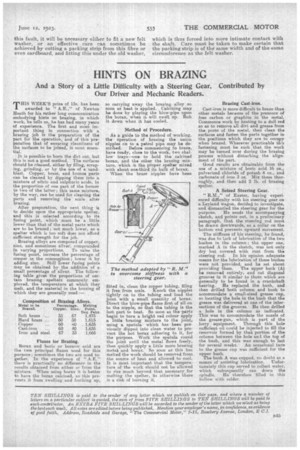HINTS ON MAINTENANCE.
Page 28

Page 29

If you've noticed an error in this article please click here to report it so we can fix it.
How to Get the Best Out of a Vehicle, to Secure Reliability and to Avoid Trouble
CONTRIBUTIONS are invited for this page from fleet managers, drivers, garage foremen, and mechanics, works staff and draughtsmen, and will be paid for on a generous scale. Every system, make, and type of commercial motor vehicle is being dealt with, and the matter should be written with a view to the disclosure of workshop and garage practice in the maintenance of a vehicle. It often happens that even a normal practice, or a practice peculiar to a particular type of vehicle, is not generally known. Expedients and suggestions for overcoming roadside and other troubles are covered in the following page, dealing with letters from our driver and mechanic readers. Communications should be addressed to " The Editor, The Commercial Motor, 7-15, Rosehery Avenue, London, E.C.1."
• 384.—The Grinding of Valves.
There are Ina,iity differences of opinion as to the number of miles a vehicle should be run before the valves of its engine are ground in. The result is that more often than not, the valves are neglected, until the compression becomes so bad that the engine loses a considerable amount of power.
Before removing the valves for grinding, run the engine until it is warm, the valve c-aps can then :be removed more readily. A dose of paraffin may help in the removal of a stubborn cap.
A valve lifter -may prove convenient in extracting the valves, and a. simple one is illustrated. This consists merely of two arms bolted together and provided -with an adjustable leg.
Sometimes a valve -rises part of the way in its stem and then jams. This is probably due to carbon deposit in the guide or a burr on the bottom of the stem. Paraffin will remove the first, and the burr can be filed off quite easily. The valves should each be nurnberciti by means of a -centre punch or with light file marks ; the latter method is perhaps the 'better as the heads may become bent by uneven blows on the top. Remove all carbon deposit from the valve cap 'seating and threads. The. handle end of a file bent into an L can be used fore-cleaning, the tang being filed to a sharp point.
The valves, if in a bad condition, will show pits and 'steps which must be removed. Grinding in such a case is useless. The valve must either be turned in a • lathe, filed in a drilling machine or cut in one of the special machines which are now made for the purpose: The grinding piste should be well thinned with oil or paraffin and smeared -tightly over the faces', of the valve and seat. Grinding should be done with a semirotary 'motion, the valve being lifted off the setting every few half-turns and dropped into a fresh position.. A light spring under the head will assist in this operation. Overgrinding should be avoided; once there is a good seating all round, that is sufficient.
B44 If there is leakage between worn stems and guides, air-tight sleeves consisting of thick felt washer soaked in a mixture of oil and blacklead, and held in position by the valve springs, will prevent the admiswon of air.
It is advisable to place a brass cap between each ei the felt washers and its spring. Be very careful to clean away all grinding paste and then set the tappets to the cerrect clearance, which is about 1-64 in. It the tappet-s canndt be.adjusted, wear on a valve 'stem can he made good by using a small piece of sheet-steel, bent over •and drilled through the upper side in the manner illustrated.
385.—Adjusting the Pedals of the 30-cwt. W. and G.
The clutch and foot-brake pedals can be adjusted to suit individual requirements by isieans of an arrangement provided at the base of each pedal. This consists of a serrated face on the pedal shaft, which is bolted up to a similar face on the clutch and foot-brake operating gear respectively.
In order to adjust either pedal it is necessary merely to loosen the retaining nut and to drive out the pin of the distance washer. The pedal is then free and can be adjusted to any desired angle within the limits imposed. Be careful to lock the adjustment after performing the operation.
386.—Taking Up Side Play on Leyland Road Wheels.
Should excessive -side play be noticed in the front or rear wheels of a Leyland vehicle, this can be remedied in the following manner
Jack up each wheel in turn and remove the cap. Carefully measure the amount of play by pushing the wheel in and -out, then remove the wheel and take from the axle arm the brass thrust washer ; -using this as a pattern, make a steel packing washer of a thickness just sufficient to take up the side play. When replacing the wheel; this new washer must be placed behind the brass 1% asher.
Another trouble with many vehicles ic that of oil leaking past the oil-retaining covers. To overcome this fault, it will be necessary either to fit a new felt washer, or an effective cure can sometimes be achieved by cutting a packing strip from this fibre or even cardboard, said fitting this under the old washer, which is thus forced into more intimate contact with the shaft. Care must be taken to make certain that the packing strip is of the same width and of the same circumference as the felt washer.






























